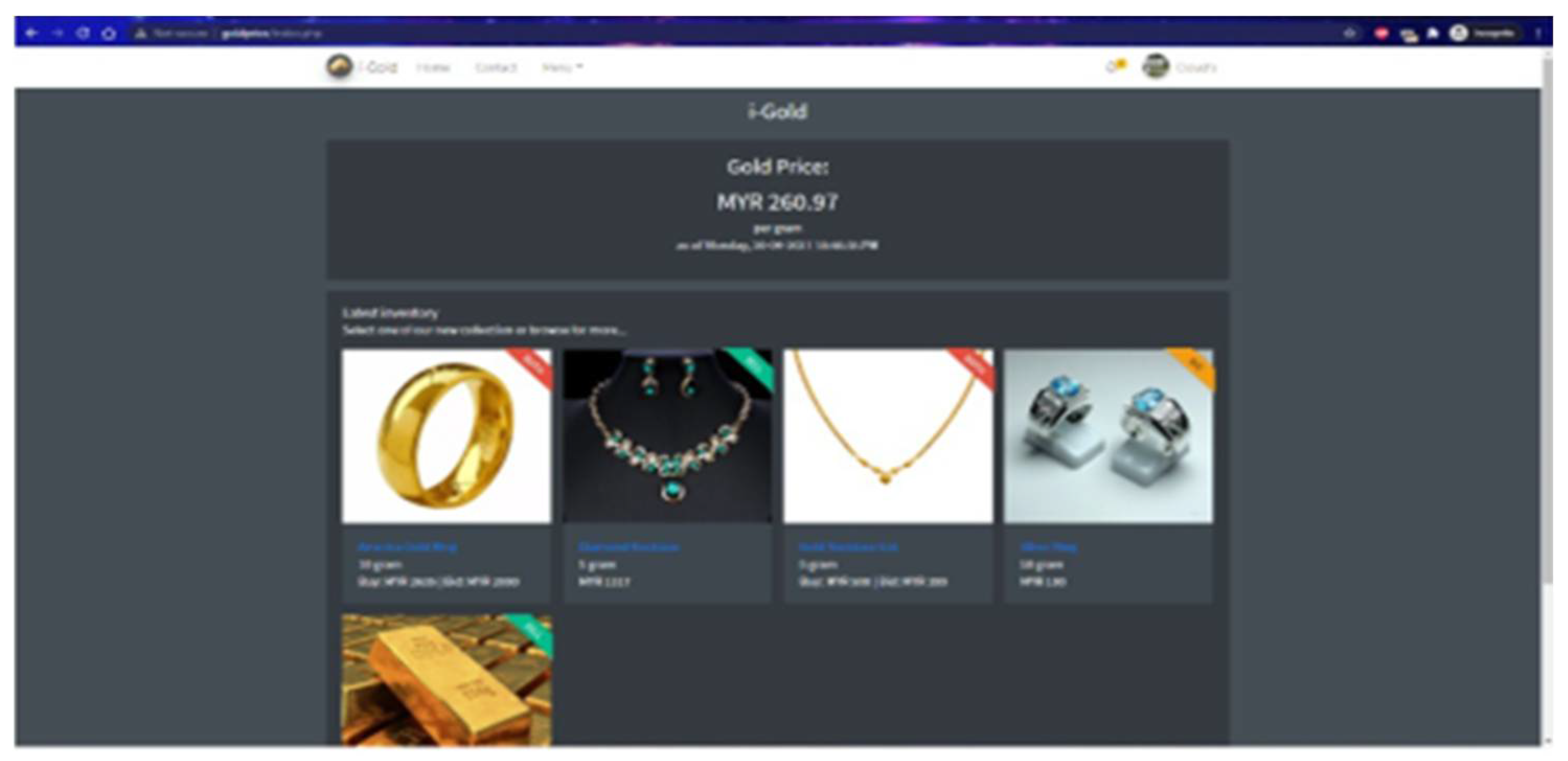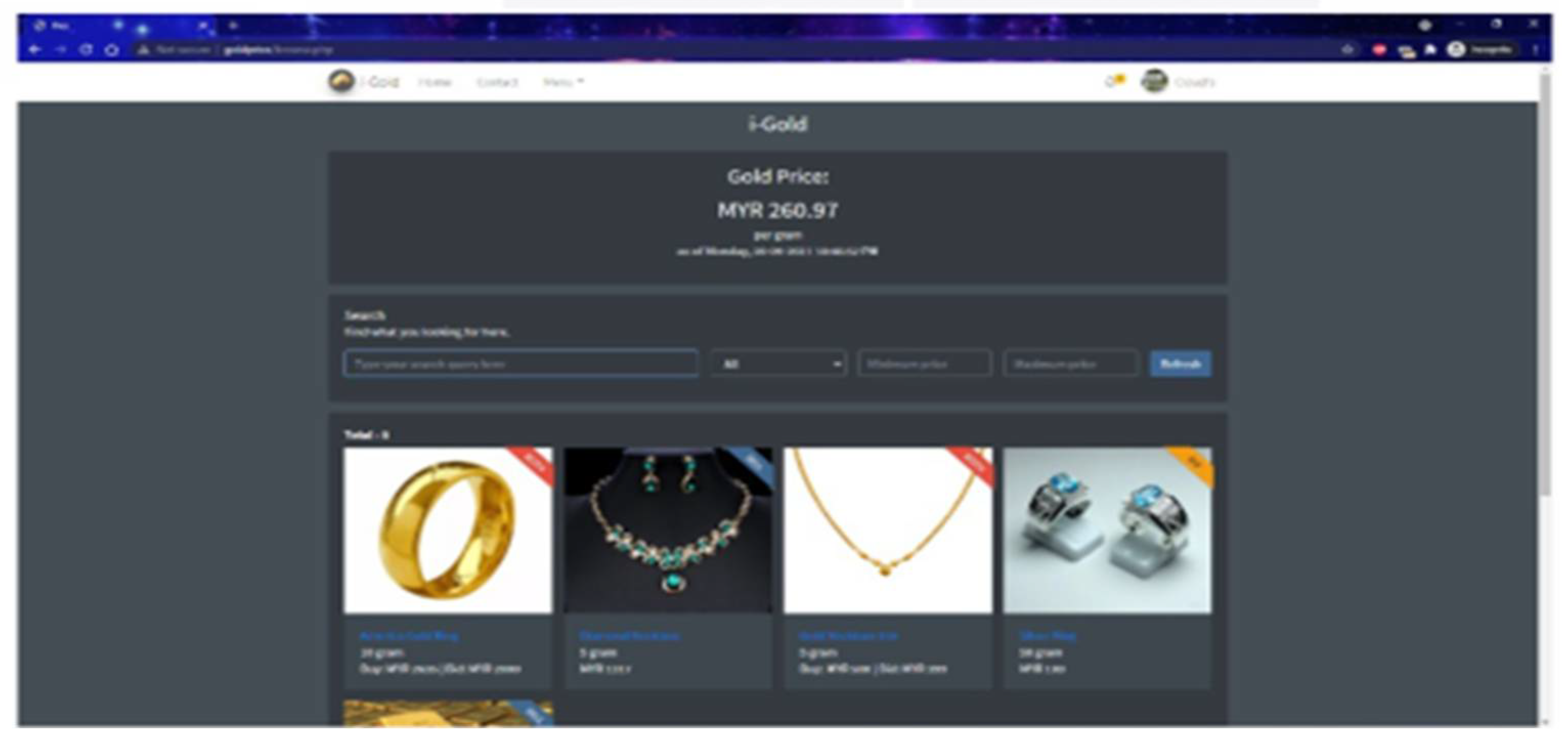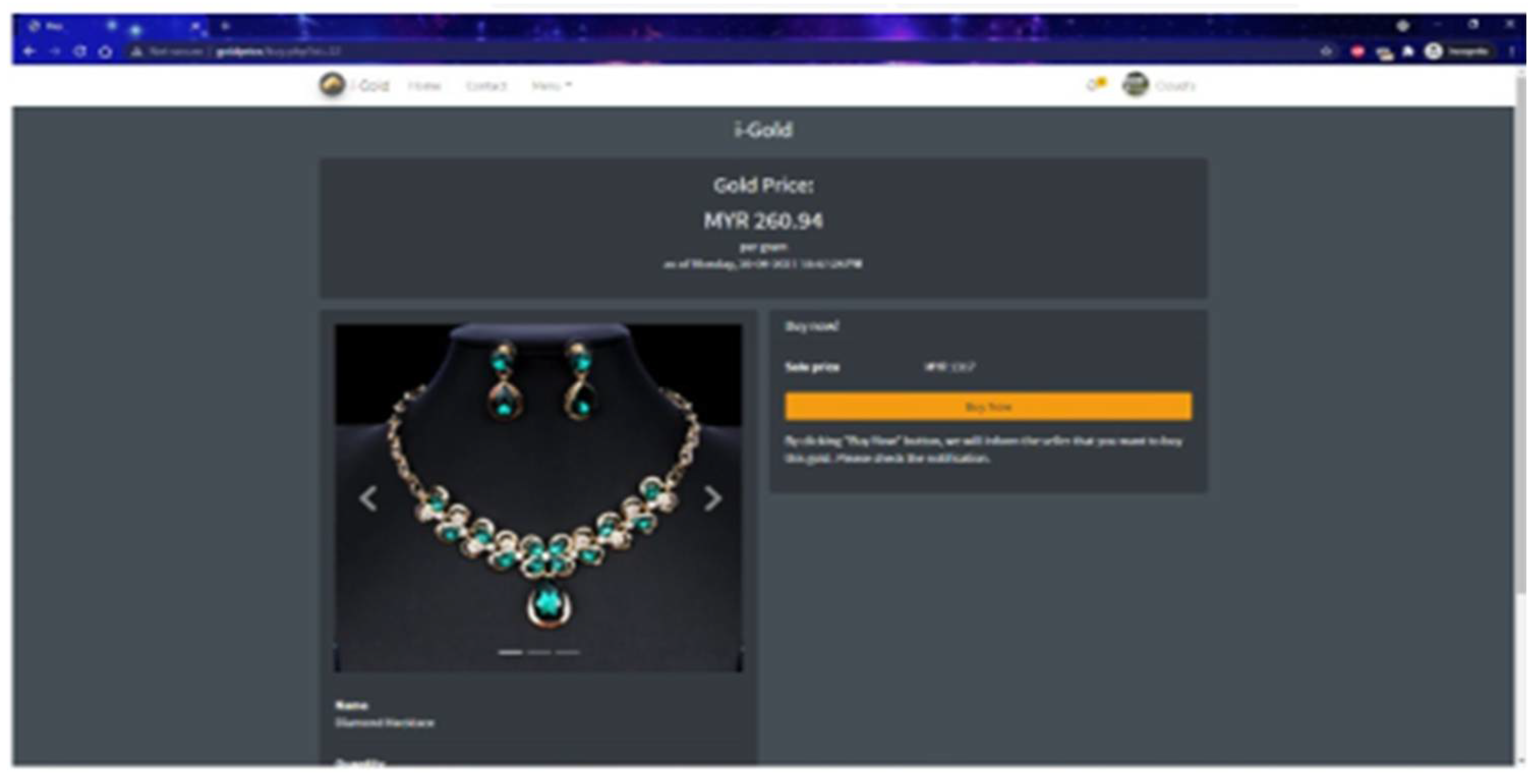Developing a COVID-19 Tool as a Web-Based Means of Assessing Gold (iGold) †
Abstract
1. Introduction
2. Literature Review
3. Background of the Study
3.1. Problem Statement
3.2. Objectives of the System’s Development
- To provide access to the current price of gold and a means of comparing the price of gold among different sellers;
- To facilitate the process of surveying and purchasing gold;
- To design and develop a web-based tool for assessing gold and evaluating performance.
4. Materials and Methods
5. Main Interfaces of the Cov_iGold System
6. Conclusions
Author Contributions
Funding
Institutional Review Board Statement
Informed Consent Statement
Data Availability Statement
Acknowledgments
Conflicts of Interest
References
- Nor, F.A.R. Kedai emas gagal patuh SOP mungkin diarah tutup. Berita Harian. 29 November 2020. Available online: https://www.bharian.com.my/berita/nasional/2020/11/759919/kedai-emas-gagal-patuh-sop-mungkin-diarah-tutup (accessed on 22 May 2022).
- Sukri, M.K.A.; Mohd, Z.N.H.; Zainal, A.N.S. The Relationship Between Selected Macroeconomic Factors and Gold Price in Malaysia. Int. J. Bus. 2015, 8, 82–193. [Google Scholar]
- Baur, D.G.; Lucey, B.M. Is Gold a Hedge or a Safe Haven? An Analysis of Stocks, Bonds and Gold. Available online: https://papers.ssrn.com/sol3/papers.cfm?abstract_id=952289 (accessed on 22 May 2022). [CrossRef]
- Kaufmann, T.; Winters, R. The price of gold: A simple model. Resour. Policy 1989, 19, 309–318. [Google Scholar] [CrossRef]
- Faugere, C.; Van Erlach, J. The price of gold: A global required yield theory. J. Invest. 2016, 14, 99–111. [Google Scholar] [CrossRef]
- Lucey, B.; Tully, E. Seasonality, risk and return in daily comex gold and silver 1980–2002. Appl. Financ. Econ. 2006, 16, 319–333. [Google Scholar] [CrossRef]
- McCown, J.; Zimmerman, J. Is Gold a Zero-Beta Asset? Analysis of the Investment Potential of Precious Metals. Available online: https://papers.ssrn.com/sol3/papers.cfm?abstract_id=920496 (accessed on 1 June 2022). [CrossRef]
- Baharom, A.H.; Mansor, H.I. The Role of gold in financial investment: A Malaysian perspective. Econ. Comput. Econ. Cybern. Stud. Res. 2011, 45, 227–238. [Google Scholar]
- Asha, K.; Christopher, S.E. A study on buying behaviour of customers towards branded and non-branded gold jewellery with preference to Kanyakumari district. Int. J. Manag. 2014, 5, 105–114. [Google Scholar]
- Raju, K.V.; Kumar, D.P. A Study on Consumer Preference on Branded Jewellery in Hyderabad. Int. J. Sales Mark. Manag. 2013, 2, 23–34. [Google Scholar]
- Hölscher, C.; Strube, G. Web search behaviour of Internet experts and newbies. Comput. Netw. 2000, 33, 337–346. [Google Scholar] [CrossRef]
- Heinonen, K. Consumer activity in social media: Managerial approaches to consumers’ social media behaviour. J. Consum. Behav. 2011, 10, 356–364. [Google Scholar] [CrossRef]
- Evans, M.; Jamal, A.; Foxall, G. Consumer Behaviour, 2nd ed.; John Wiley & Sons Ltd.: Hoboken, NJ, USA, 2009. [Google Scholar]
- Impact of Social Media on Purchasing Behavior. Available online: http://174.133.170.120/files/DEIStudyEngaging%20ConsumersOnlineSummary.pdf (accessed on 24 May 2022).
- José, G.S.M.; Gutiérrez, A.A.M.; San, J.C.R. Determinants of internet use in the purchasing process. J. Bus. Ind. Mark. 2006, 21, 164–174. [Google Scholar] [CrossRef]
- Hoffman, D.; Novak, T.; Chatterjee, P. Commercial scenarios for the web: Opportunities and challenges. J. Comput.-Mediat. Commun. 1995, 1, JCMC136. [Google Scholar] [CrossRef]
- Bhoomika, K.M.; Neetha, M. Consumer buying behaviour and trust towards online jewellery shopping. J. Bus. Manag. 2020, 22, 9. [Google Scholar]
- Corbitt, B.; Thanasankit, T.; Han, Y. Trust on the World Wide Web: A study of consumer perceptions. Sch. Work. Pap. Ser. 2017, 2, 34–37. [Google Scholar]
- Kalia, P.; Kaur, N.; Singh, T. A review of factors affecting online buying behaviour. Apeejay J. Manag. Technol. 2016, 1, 58–73. [Google Scholar]
- Mohammed, M.E.; Walid, M.A.; Abdullah, A. Price and volatility spillovers between global equity, gold, and energy markets prior to and during the COVID-19 pandemic. Resour. Policy 2021, 74, 102–334. [Google Scholar]
- Nor, F.A.R. Orang ramai serbu kedai emas di Kota Bharu. Berita Harian. 29 November 2020. Available online: https://www.bharian.com.my/berita/nasional/2020/11/759706/orang-ramai-serbu-kedai-emas-di-kota-bharu (accessed on 22 May 2022).
- Yoganandham, G.; Govindaraj, A.; Kumaran, P.S. Knowledge, awareness, attitude and purchasing decision making behaviour among women towards gold jewellery in vellore city–an assessment. Int. Rev. Bus. Econ. Spec. Issue 2020, 4, 300–311. [Google Scholar]
- Baur, D.G.; McDermott, T.K.J. Why is Gold a Safe Haven? J. Behav. Exp. Financ. 2016, 10, 63–71. [Google Scholar] [CrossRef]
- Hoffer, J.A.; George, J.; Valacich, J.S. Modern Systems Analysis and Design; Pearson: Boston, MA, USA, 2017. [Google Scholar]
- Rosman, M.R.M.; Abdullah, R.Y.R.; Salleh, M.I.M. Development of Vehicle Observation System as security mechanism towards electronic records conversion. In Proceedings of the 2010 International Conference on Science and Social Research (CSSR 2010), Kuala Lumpur, Malaysia, 5–7 December 2010; pp. 699–704. [Google Scholar]
- Taylor, M. A General Understanding of Microsoft Excel, Visual Studio and Webmatrix. Available online: http://533507.weebly.com/notepad.html (accessed on 25 May 2022).
- Chen, Y.; You, H. Selection and Research for Online Registration System’s. J. Softw. Eng. Appl. 2017, 6, 33. [Google Scholar] [CrossRef][Green Version]
- Maintenance Phase in SDLC. Available online: https://study.com/academy/lesson/maintenance-phase-in-sdlc.html (accessed on 22 May 2022).




Publisher’s Note: MDPI stays neutral with regard to jurisdictional claims in published maps and institutional affiliations. |
© 2022 by the authors. Licensee MDPI, Basel, Switzerland. This article is an open access article distributed under the terms and conditions of the Creative Commons Attribution (CC BY) license (https://creativecommons.org/licenses/by/4.0/).
Share and Cite
Rahman, K.A.; Nawi, N.A.M.M.; Said, A.; Zainudin, F.M.I.; Mustapha, W.M.W.; Shaari, A.S. Developing a COVID-19 Tool as a Web-Based Means of Assessing Gold (iGold). Proceedings 2022, 82, 27. https://doi.org/10.3390/proceedings2022082027
Rahman KA, Nawi NAMM, Said A, Zainudin FMI, Mustapha WMW, Shaari AS. Developing a COVID-19 Tool as a Web-Based Means of Assessing Gold (iGold). Proceedings. 2022; 82(1):27. https://doi.org/10.3390/proceedings2022082027
Chicago/Turabian StyleRahman, Khadijah Abdul, Nur Ainatul Mardiah Mat Nawi, Asiah Said, Fadhilah Mohd Ishak@ Zainudin, Wan Masnieza Wan Mustapha, and Asma Shazwani Shaari. 2022. "Developing a COVID-19 Tool as a Web-Based Means of Assessing Gold (iGold)" Proceedings 82, no. 1: 27. https://doi.org/10.3390/proceedings2022082027
APA StyleRahman, K. A., Nawi, N. A. M. M., Said, A., Zainudin, F. M. I., Mustapha, W. M. W., & Shaari, A. S. (2022). Developing a COVID-19 Tool as a Web-Based Means of Assessing Gold (iGold). Proceedings, 82(1), 27. https://doi.org/10.3390/proceedings2022082027





